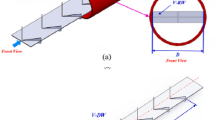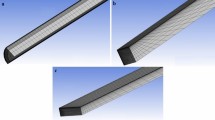Abstract
Generally, there are two main methods to increase the thermal performance of the heat exchanger, which include active and passive methods. Passive mode, unlike active mode, does not need external power which the heat transfer rate can be increased by utilizing changes in the flow regime or direction of the fluid path. In the present survey, numerical analysis of the effect of geometrical and operational parameters on the thermal performance of a convergent–divergent tube is done. Numerical simulations are performed using the commercial CFD code. The investigated geometrical parameters include the large and smaller diameters of the cone’s wall, the pitch of the cone and the height of the roughness. Obtained results in the first section indicate that the proposed wavy geometry leads to enhanced heat transfer in the pipe. In the second section of the study, instead of pure water, two types of water-based nanofluids, including water/Al2O3 and water/CuO, are utilized, and the obtained results are compared with pure water. Results indicate that water/Al2O3 nanofluid has better thermal performance than CuO/water and especially pure water. As a result, it can be said that for water/Al2O3 nanofluid at low Reynolds number (Re = 10,000), the case with φ = 4% has 9.29% more thermal performance than pure water which has the highest thermal performance. Also, at high Reynolds number (Re = 20,000), the case with φ = 5% has 7.15% more thermal performance than pure water. The lowest thermal performance improvement in comparison with pure water belongs to the case with φ = 2% at high Reynolds number (Re = 20,000) with about 6%. Also, for water/CuO nanofluid, the case with φ = 3% at low Reynolds number (Re = 10,000) and the case with φ = 5% at high Reynolds number (Re = 20,000) have highest and lowest thermal performance improvement in comparison with pure water with 8.86% and 6.25%, respectively.


























Similar content being viewed by others
References
Rainieri S, Pagliarini G. Convective heat transfer to temperature dependent property fluids in the entry region of corrugated tubes. Int J Heat Mass Transf. 2002;45(22):4525–36.
Promvonge P, Eiamsa-ard S. Heat transfer behaviors in a tube with combined conical-ring and twisted-tape insert. Int Commun Heat Mass Transfer. 2007;34:849–59.
Garcia A, Solano JP, Vicente PG, Viedma A. The influence of artificial roughness shape on heat transfer enhancement: corrugated tubes, dimpled tubes and wire coils. Appl Therm Eng. 2012;35:196–201.
Eiamsa-ard S, Yongsiri K, Nanan K, Thianpong C. Heat transfer augmentation by helically twisted tapes as swirl and turbulence promoters. Chem Eng Process. 2012;60:42–8.
Darzi AAR, Farhadi M, Sedighi K, Aallahyari SH, Delavar MA. Turbulent heat transfer of Al2O3–water nanofluid inside helically corrugated tubes: numerical study. Int Commun Heat Mass Transfer. 2013;41:68–75.
Mohammadi K, Sabzpooshani M. Comprehensive performance evaluation and parametric studies of single pass solar air heater with fins and baffles attached over the absorber plate. Energy. 2013;57:741–50.
Naik MT, Fahad SS, Sundar LS, Singh MK. Comparative study on thermal performance of twisted tape and wire coil inserts in turbulent flow using CuO/water nanofluid. Exp Thermal Fluid Sci. 2014;57:65–76.
Esmaeilzadeh E, Almohammadi H, Nokhosteen A, Motezaker A, Omrani AN. Study on heat transfer and friction factor characteristics of g-Al2O3/water through circular tube with twisted tape inserts with different thicknesses. Int J Therm Sci. 2014;82:72–83.
Zohir AE, Aziz AAA, Habib MA. Heat transfer characteristics and pressure drop of the concentric tube equipped with coiled wires for pulsating turbulent flow. Exp Thermal Fluid Sci. 2015;65:41–51.
Kareem ZS, Abdullah S, Lazim TM, MohdJaafar MN, Wahid AFA. Heat transfer enhancement in three-start spirally corrugated tube: experimental and numerical study. Chem Eng Sci. 2015;134:746–57.
Bhuiya MMK, Azad AK, Chowdhury MSU, Saha M. Heat transfer augmentation in a circular tube with perforated double counter twisted tape inserts. Int Commun Heat Mass Transfer. 2016;74:18–26.
Afsharpanah F, Pakzad K, Amirsoleymani M, Delavar MA. Numerical study of heat transfer enhancement using perforated dual twisted tape inserts in converging–diverging tubes. Heat Transf Asian Res. 2018;47(5):754–67.
Nakhchi ME, Esfahani JA. Entropy generation of turbulent Cu–water nanofluid flow in a heat exchanger tube fitted with perforated conical rings. J Therm Anal Calorim 2019. https://doi.org/10.1007/s10973-019-08169-w.
Toghraie D, Abdollah MM, Pourfattah F, Akbari OA, Ruhani B. Numerical investigation of flow and heat transfer characteristics in smooth, sinusoidal and zigzag-shaped microchannel with and without nanofluid. J Therm Anal Calorim. 2018;131(2):1757–66.
Bhattacharyya S, Pal SK, Pop I. Impact of nanoparticles migration on mixed convection and entropy generation of a Al2O3–water nanofluid inside an inclined enclosure with wavy side wall. J Therm Anal Calorim 2019. https://doi.org/10.1007/s10973-019-08345-y.
Mohebbi R, Izadi M, Delouei AA, Sajjadi H. Effect of MWCNT–Fe3O4/water hybrid nanofluid on the thermal performance of ribbed channel with apart sections of heating and cooling. J Therm Anal Calorim. 2019;135(6):3029–42.
Sajid MU, Ali HM, Sufyan A, Rashid D, Zahid SU, Rehman WU. Experimental investigation of TiO2–water nanofluid flow and heat transfer inside wavy mini-channel heat sinks. J Therm Anal Calorim. 2019;137(4):1279–94.
Kuppusamy NR, Mohammed HA, Lim CW. Numerical investigation of trapezoidal grooved microchannel heat sink using nanofluids. Thermochim Acta. 2013;573:39–56.
Kuppusamy NR, Mohammed HA, Lim CW. Thermal and hydraulic characteristics of nanofluid in a triangular grooved microchannel heat sink (TGMCHS). Appl Math Comput. 2014;246:168–83.
Mohammed HA, Narrein K. Thermal and hydraulic characteristics of nanofluid flow in a helically coiled tube heat exchanger. Int Commun Heat Mass Transfer. 2012;39(9):1375–83.
Narrein K, Mohammed HA. Influence of nanofluids and rotation on helically coiled tube heat exchanger performance. Thermochim Acta. 2013;564:13–23.
Mohammed HA, Golieskardi M, Munisamy KM. Numerical investigation of combined convection and nanofluids flow over backward facing step in a channel having a blockage. J Comput Theor Nanosci. 2014;11(4):971–80.
Fluent AN. 18.2, theory guide. Canonsburg: ANSYS Inc.; 2017.
Shih TH, Liou WW, Shabbir A, Yang Z, Zhu J. A new k–ε Eddy viscosity model for high reynolds number turbulent flows. Comput Fluids. 1995;24:227–38.
Xuan Y, Roetzel W. Conceptions for heat transfer correlation of nanofluids. Int J Heat Mass Transf. 2000;43(19):3701–7.
Piper M, Tran JM, Kenig EY. A CFD study of the thermo-hydraulic characteristics of pillow-plate heat exchangers. In: ASME 2016 heat transfer summer conference collocated with the ASME 2016 fluids engineering division summer meeting and the ASME 2016 14th international conference on nanochannels, microchannels, and minichannels. American Society of Mechanical Engineers; 2016. pp. V001T05A002.
Corcione M. Empirical correlating equations for predicting the effective thermal conductivity and dynamic viscosity of nanofluids. Energy Convers Manag. 2011;52(1):789–93.
Pak BC, Cho YI. Hydrodynamic and heat transfer study of dispersed fluids with submicron metallic oxide particles. Exp Heat Transf Int J. 1998;11(2):151–70.
Sharma KV, Sarma PK, Azmi WH, Mamat R, Kadirgama K. Correlations to predict friction and forced convection heat transfer coefficients of water based nanofluids for turbulent flow in a tube. Int J Microscale Nanoscale Therm Fluid Transp Phenom. 2012;3(4):283.
Fotukian SM, Esfahany MN. Experimental study of turbulent convective heat transfer and pressure drop of dilute CuO/water nanofluid inside a circular tube. Int Commun Heat Mass Transfer. 2010;37(2):214–9.
Baragh S, Shokouhmand H, Ajarostaghi SS, Nikian M. An experimental investigation on forced convection heat transfer of single-phase flow in a channel with different arrangements of porous media. Int J Therm Sci. 2018;1(134):370–9.
Ko KH, Anand NK. Use of porous baffles to enhance heat transfer in a rectangular channel. Int J Heat Mass Transf. 2003;46(22):4191–9.
Chang SW, Liou TM, Chiang KF, Hong GF. Heat transfer and pressure drop in rectangular channel with compound roughness of V-shaped ribs and deepened scales. Int J Heat Mass Transf. 2008;51:457–68.
Kurtbaş İ, Gülçimen F, Akbulut A, Buran D. Heat transfer augmentation by swirl generators inserted into a tube with constant heat flux. Int Commun Heat Mass Transfer. 2009;36(8):865–71.
Baragh S, Shokouhmand H, Ajarostaghi SSM. Experiments on mist flow and heat transfer in a tube fitted with porous media. Int J Therm Sci. 2019;137:388–98.
Noorbakhsh M, Zaboli M, Ajarostaghi SS. Numerical evaluation of the effect of using twisted tapes as turbulator with various geometries in both sides of a double-pipe heat exchanger. J Therm Anal Calorim 2019. https://doi.org/10.1007/s10973-019-08509-w.
Shirzad M, Delavar MA, Ajarostaghi SSM, Sedighi K. Evaluation the effects of geometrical parameters on the performance of pillow plate heat exchanger. Chem Eng Res Des. 2019;150:74–83.
Shirzad M, Ajarostaghi SSM, Delavar MA, Sedighi K. Improve the thermal performance of the pillow plate heat exchanger by using nanofluid: numerical simulation. Adv Powder Technol. 2019;30(7):1356–65.
Author information
Authors and Affiliations
Corresponding author
Additional information
Publisher's Note
Springer Nature remains neutral with regard to jurisdictional claims in published maps and institutional affiliations.
Rights and permissions
About this article
Cite this article
Hamedani, F.A., Ajarostaghi, S.S.M. & Hosseini, S.A. Numerical evaluation of the effect of geometrical and operational parameters on thermal performance of nanofluid flow in convergent–divergent tube. J Therm Anal Calorim 140, 1483–1505 (2020). https://doi.org/10.1007/s10973-019-08765-w
Received:
Accepted:
Published:
Issue Date:
DOI: https://doi.org/10.1007/s10973-019-08765-w




